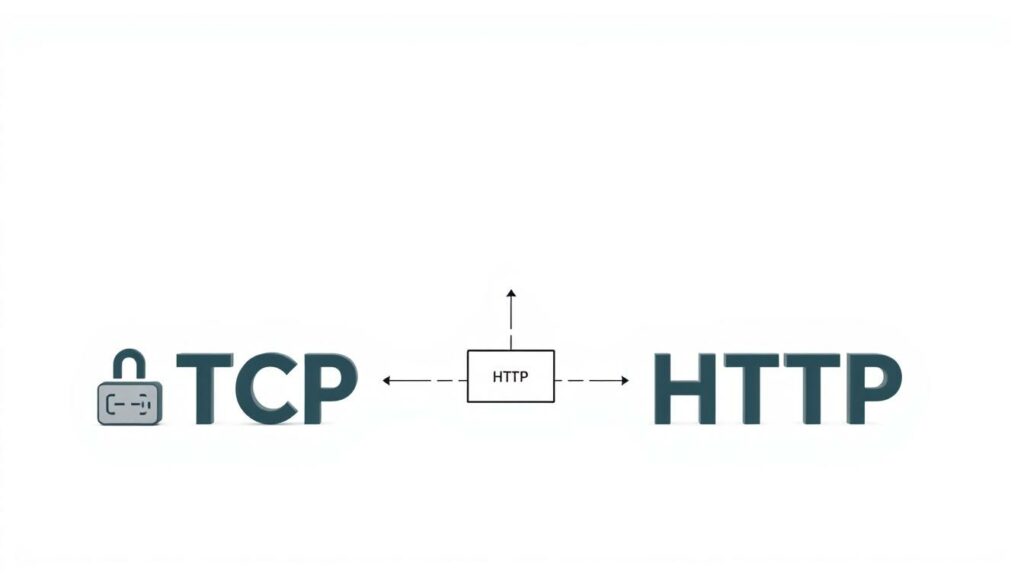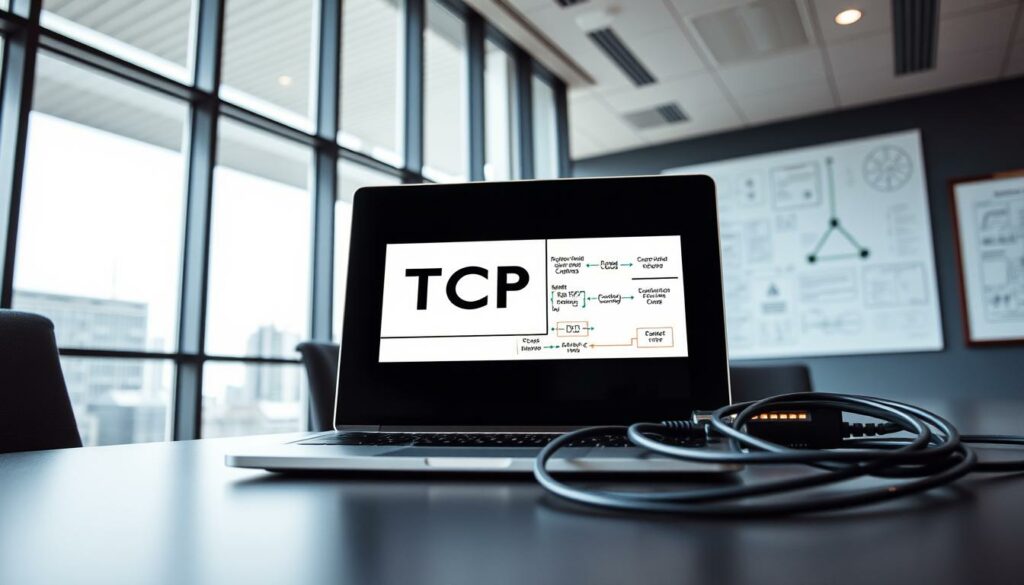TCP vs HTTP: Key Differences Between TCP and HTTP Explained
When you load a website or stream a video, two powerful protocols are working behind the scenes: TCP and HTTP. But what exactly sets them apart? Why does one focus on reliability and the other on simplicity? And how do they work together to make your internet experience seamless?
In this article, we’ll explore the unique roles TCP and HTTP play in online communication. We’ll look at why HTTP relies on TCP for reliable data delivery across the internet. We’ll also examine how their stateless and stateful designs impact page loading and web performance.
Keep reading to uncover the key differences and discover how these foundational technologies shape the way we use the internet every day.
Introduction to TCP and HTTP
Knowing the difference between TCP and HTTP is key for web tech and networking experts. TCP (Transmission Control Protocol) and HTTP (Hypertext Transfer Protocol) have different roles in online communication. A comparison shows their unique functions and traits.
TCP operates at Layer 4 of the OSI model, ensuring reliable data transmission between devices. It uses a three-way handshake to start connections and ensures data reaches its destination. TCP also manages the data flow and uses positive acknowledgment with retransmission to keep data safe.
HTTP, at Layer 7, helps web browsers talk to servers. It uses port 80 and sends hypertext messages. HTTP is quicker than TCP because it’s faster. It works within TCP’s stream, making web pages and content load.
Both protocols are vital for the internet to work. TCP supports apps like HTTP, FTP, and email. HTTP handles web interactions. Knowing these protocols helps improve network performance and fix connection problems.
The Role of TCP in Networking
TCP is key in networking for reliable data sending. It divides data into packets, ensures they reach their destination, and puts them back together. This is crucial for TCP vs HTTP communication, as TCP is the base for many protocols.
TCP is connection-oriented, meaning it sets up a connection before sending data. This involves a three-way handshake: request, acknowledgment, and confirmation of acknowledgment. This makes sure the connection is stable for the whole communication.
TCP’s reliability comes from its error fixing and speed control. If TCP detects lost packets, it requests them to be sent again. It also regulates data transmission speed to match the receiver’s capacity, preventing overload.
Even though TCP might be slower than some options, it’s vital for apps where data accuracy is key. Web servers use TCP for HTTP, showing its role in our daily online activities.
The Role of HTTP in Web Communication
HTTP is key in web communication, linking web browsers and servers. It uses a request-response model to send messages over the internet. When you enter a web address, your browser sends a request to the server. The server then sends back the data you asked for.
HTTP operates as a stateless protocol. This means the server handles each request independently, without retaining information from previous interactions. This helps websites grow, but it makes keeping user sessions tricky. To solve this, developers use cookies or server-side sessions.
HTTP depends on TCP for sending data reliably. This shows how HTTP and TCP work together in web communication. HTTP handles application data like HTML, while TCP ensures accurate and orderly data transmission.
HTTP can handle many types of content, like HTML, JSON, and images. It uses methods like GET and POST to manage data. With HTTP/2, sending multiple requests at once has become faster.

Key Differences Between TCP and HTTP
It’s important to know how TCP and HTTP differ in web communication. TCP works at the transport layer, while HTTP is at the application layer. This shows their unique roles in networking.
TCP ensures reliable data delivery by managing connections and retransmitting any lost packets. It’s essential for many protocols, including HTTP. On the other hand, HTTP handles the format of data transfer, like sending requests and responses between servers and clients.
The TCP/IP model has five layers, and the OSI model has seven. TCP is in the transport layer, working with IP to move data. HTTP, being in the application layer, focuses on delivering web content.
A big difference is their scope. TCP handles connections all over the internet, while HTTP deals with web traffic. Most HTTP communication uses TCP/IP, showing how they work together on the web.
Performance Considerations
TCP ensures 100% data integrity through checks and retransmissions. This makes it ideal for applications requiring accuracy, like file transfers, emails, and database queries. However, this reliability can come at the cost of speed due to the connection setup and retransmission process.
HTTP, especially with advancements like HTTP/2, improves performance through multiplexing — sending multiple requests over one TCP connection. HTTP is typically faster for short, bursty communication like browsing websites or loading APIs.
In speed tests, BSD-Linux implementations of TCP have demonstrated faster throughput compared to Denali-Linux. However, TCP’s inherent structure can reduce the speed of large data transfers by 20–30%. HTTP’s quick startup and lightweight design make it effective for many everyday web interactions.
Typical Use Cases for TCP
TCP is key in many online activities. It’s the base for HTTP’s reliable data transfer. This shows TCP’s wide use, not just for web browsing.
File transfers need TCP. It makes sure your files get to their destination right. Email services also use TCP to send messages without mistakes.
Remote administration tools depend on TCP for security. System admins use it to manage servers and devices safely. TCP is also great for database access, keeping data safe during updates.
Video streaming services use TCP for on-demand content. While live streaming might use UDP for speed, TCP is better for pre-recorded videos. VPNs also use TCP for secure, encrypted connections.

Security Aspects of TCP and HTTP
TCP and HTTP differ in their security features. TCP is vital for communication but lacks built-in protections. It’s vulnerable to threats like IP spoofing and SYN floods.
These attacks can disrupt services or compromise data. HTTP sends unencrypted data, making it easy for hackers to intercept sensitive information. To address this, developers introduced HTTPS.
HTTPS secures communication using SSL/TLS encryption. It operates on port 443, while HTTP uses port 80. This shift helps protect user data.
Search engines rank HTTPS sites higher due to enhanced trust. Users also feel safer seeing the padlock icon in their browsers.
Ultimately, HTTPS offers stronger security by protecting sensitive data like credit card numbers. While TCP remains essential for data delivery, it needs support from secure protocols to guard against cyber threats.
Typical Use Cases for HTTP
HTTP is key to how we use the web. It helps load web pages and makes online experiences rich. When you visit a website, HTTP helps your browser and servers talk to each other.
In today’s web apps, HTTP is a star. It enables API communications, allowing different systems to exchange information seamlessly. This is vital for microservices, where many services work together to build complex apps.
HTTP’s design makes it scalable. Each request is independent, so servers can handle lots of traffic. This is great for big web services that need to serve many users at once.
When we look at TCP vs HTTP, remember HTTP runs on top of TCP. TCP ensures data gets there safely, while HTTP organizes web communication. This shows how they work together to make the web smooth.
Future Trends in TCP and HTTP
The world of internet protocols is changing fast. TCP vs HTTP performance is a big topic as new tech comes out. HTTP/3 and QUIC are at the forefront, aiming for faster and safer connections.
QUIC, the base of HTTP/3, brings big benefits over TCP. It allows for 0-RTT connections, skipping TCP’s three-way handshake. This makes websites load faster, better for users. QUIC also handles multiple streams in one connection, cutting down on delays.
In the battle of TCP vs HTTP, QUIC’s encryption with TLS 1.3 stands out. Unlike TCP, which needs an extra handshake for encryption, QUIC makes it smoother. This boosts security and cuts down setup time. Sharing big video files gets easier and quicker with these updates.
Looking ahead, HTTP/3 will transform the way we communicate online. Big names like Google Chrome and Mozilla Firefox are working on it. With speeds up to 10 Gbps and 5G, HTTP/3 is ushering in a new era of connectivity. The internet is evolving, and these protocols are leading the charge.
From Packets to Pages: Unlocking the Power of TCP and HTTP
TCP and HTTP aren’t just jargon — they’re the foundation of modern internet communication. TCP delivers data accurately and in order, while HTTP structures that data into the content we interact with every day. Together, they enable everything from simple web browsing to complex content delivery systems.
Understanding how these protocols work isn’t just for network engineers — it’s essential for anyone building or managing digital experiences. And if you’re sharing large files, videos, or embedded media, the right infrastructure matters.
That’s where DivShare comes in. Our platform handles fast, reliable content hosting by leveraging the same powerful principles behind TCP and HTTP. Whether you’re a developer, educator, or creator, DivShare makes it easy to store, manage, and share your media securely and efficiently.
Sign up today and start sharing smarter with a platform built on the web’s most trusted technologies.